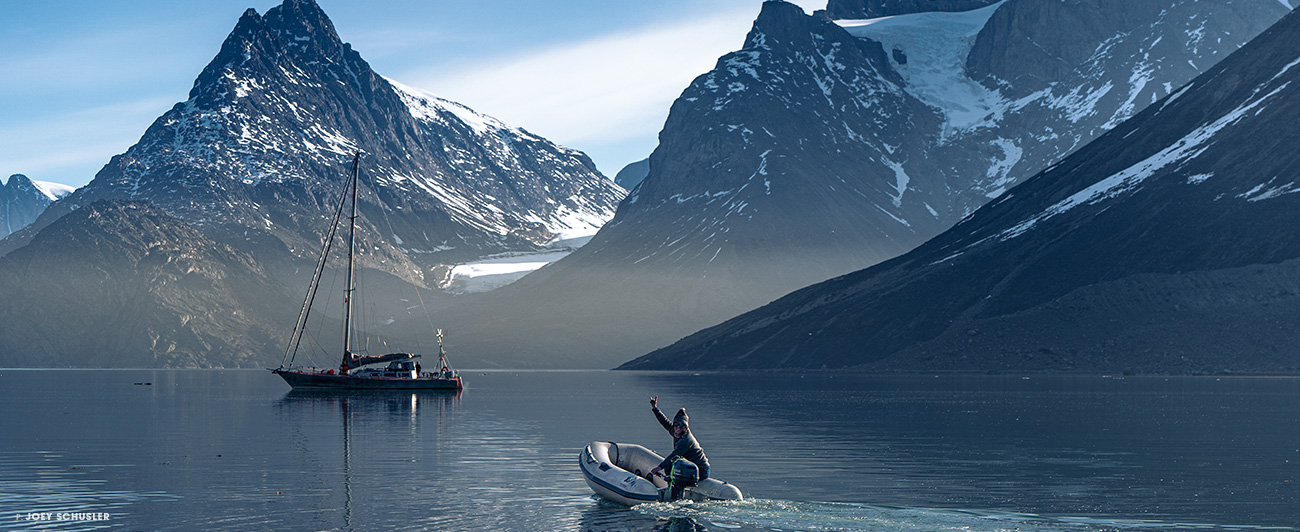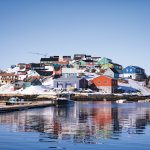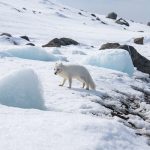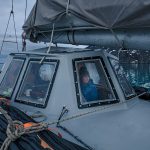Adventure
Greenland
Arctic Artistry: Tempting Sea and Sky in Greenland
First published in issue 16.3 of The Ski Journal.
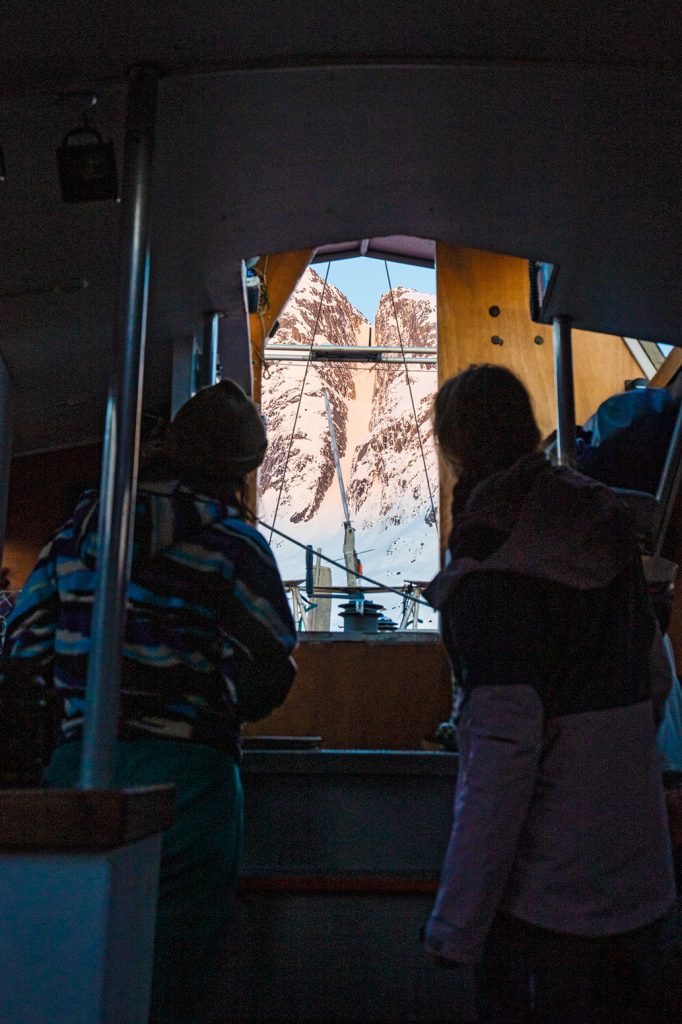
“During our 2022 trip, Jess and Rachael peek out the door of the Knut at a line we dubbed the Maniitsoq Mainline given it’s alluring, almost addictive appearance.”
Photo: Sophie Danison
The Knut is no yacht. It is a 50-foot, Italian-made aluminum racing sailboat that felt a bit out of place in the Arctic. It sleeps five, including the captain. While I had lived off the Knut on two prior occasions, it had undergone substantial changes since my last voyage. It had been stripped of diesel lines and now sported a small electric engine. All five bunks were full with our lead guide Jess Baker, photographers Erich Roepke and Sophie Danison, captain Ben Ruffieux and me. With the new “Eco-Knut” as our base camp, we were here to explore and ski some of the most remote terrain on Earth.
Our crew had already spent weeks ticking off lines from the boat. Even with only a few hours of true daylight, the days felt long, with extended treks across Greenland’s immense ice fields to approach dizzying first descents.
Now my fatigued legs had caught up with me, and as wind cut through my base layers, I watched as our markers for every 10 meter of chain wound themselves back into the anchor winch. When we got to the last marker, I slowed the roll to observe the anchor crest the surface of wind-ruffled ocean. But as the final meter of chain retreated into the boat, my heart skipped a beat. The anchor was gone.
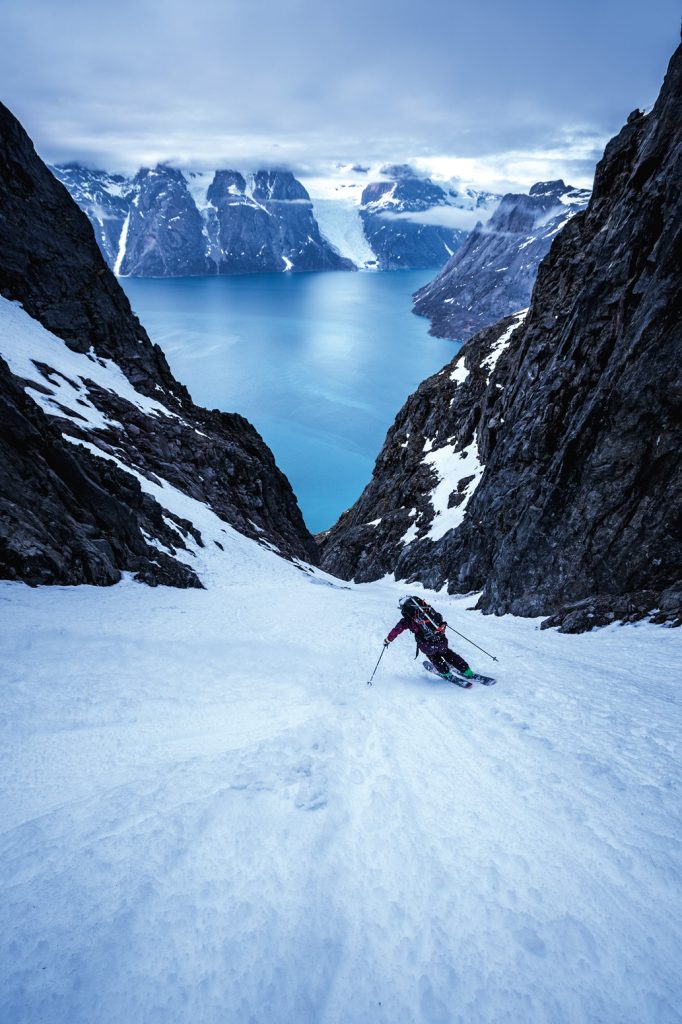
“As the trip progressed, we found ourselves on steeper and steeper terrain. It was often quite hard to understand what we were getting into while window shopping from the boat, but just about every line was unlike anything I had ever skied. This particular couloir led to a large snowfield above, where we basked in the sunshine before descending back into the clouds.” Photo: Joey Schusler
Skiing season is not necessarily sailing season in the Arctic. Sailboats cannot navigate if large parts of the coast are iced over. Before crossing into Arctic waters, boats must carefully monitor sea ice and weather patterns to ensure safety upon arrival. Captain Ben, who was set to arrive with the Knut on May 1—the same time as the rest of us flew in from around the world—was not afforded the luxury of being able to wait for a perfect weather window. Greenland experienced an extremely cold spring in 2022, receiving six feet of snow days before we arrived. Ben sailed solo from the Canary Islands, over 2,620 nautical miles through that storm cycle, for three weeks. My heart, having been so excited to see Ben and the Knut, sank immediately when the Knut arrived completely out of power and coated with a thick layer of ice.
Ben is a visionary. Born in landlocked Switzerland, by the time he turned 10 years old, he could sail an Olympic class dinghy. At 13, he told his family he was going to buy a sailboat and sail around the world. He went to college to become a photographer, but by 23 he and a friend had rebuilt an engineless 30-foot sailboat named the Dira, and spent the next seven years trans-navigating the globe. They floated without wind for weeks in open ocean and even wrecked off the coast of Patagonia. Despite the high-seas experience, Ben, now in his late 30s, is anything but a swashbuckling sailor. He stands medium height with strawberry blond hair that defies gravity. He is an artist. He reads a book a day and has published several of his own. He jokes that he is more a janitor than a sailor because he is constantly fixing everything.
He does not typically work with skiers. Ben runs a nonprofit called MaréMotrice, bringing artists into the wilds of the Arctic. “Taking artists to the sea or around icebergs has a particularity,” he says. “It is their job to feel the place and what is happening there—it is their job to transmit what they see and experience on a sensory and emotional level.”
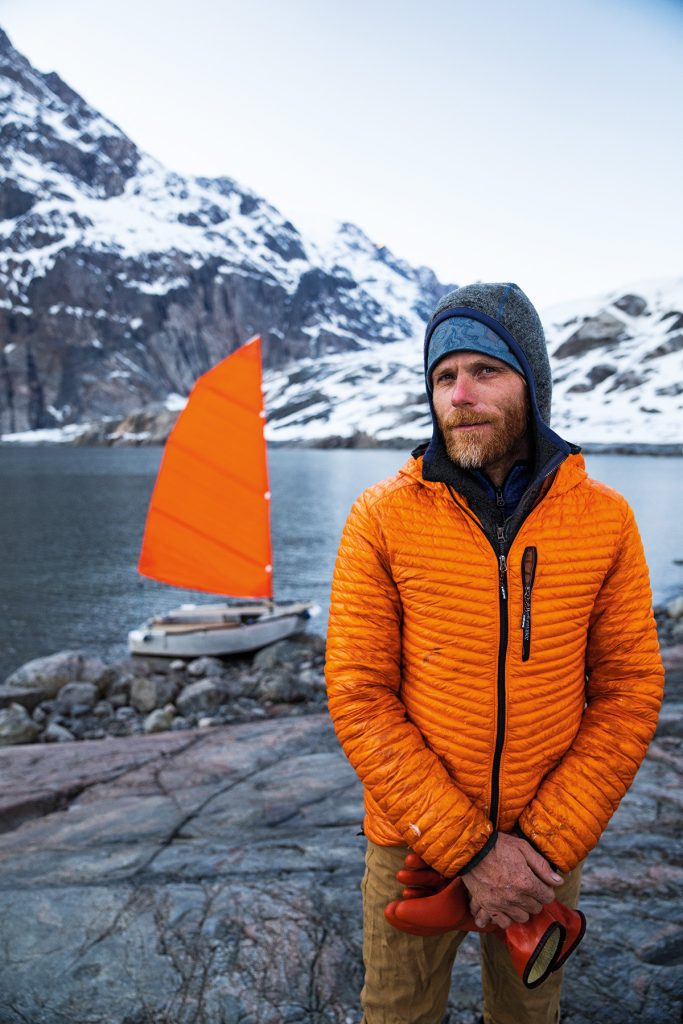
“The only remaining ‘non-green’ part of the Knut setup is the gas engine on the dinghy, so Ben experimented with putting a small sail on the boat—which he fabricated himself, of course—to come pick us up from shore on a particularly breezy evening. The path from the Knut to shore and back was a bit more circuitous in the ‘eco-dinghy,’ but gave everyone a good laugh.” Photo: Sophie Danison
Ben believes in the power of art. He believes that if he can take artists through the presence of this ever-changing icy greatness that they can capture and portray its sacred beauty though artistic expression. Lucky for Jess, our expedition leader and professional mountain guide, Ben sees skiing as a form of art.
Jess is an AMGA-certified ski and alpine guide with one remaining certification to be a fully-credentialed IFMGA/AMGA guide. She is a mother of two bright little girls and married to another extremely accomplished mountain guide—in other words, she is forever connected to the mountains. We first met 20 years ago and I knew then that Jess was her own kind of visionary—she just comes up with an idea and figures out how to make it a reality.
Ben and Jess both dream in challenges. They met in 2016 in Svalbard, Norway, and immediately became like family. They have led parallel lives in their different disciplines, but each has two children about the same ages, run their own businesses, and are passionately drawn to sharing the Arctic with others. They decided to partner for a 2016 expedition and immediately challenged each other’s norms. Jess wanted to access larger mountains in the south of Svalbard, which are not easily reached from the port town of Longyearbyen. To ski those southern ranges, Ben’s solution was for Jess and crew to make the arduous crossing from Hammerfest, Norway, to Svalbard the following year.
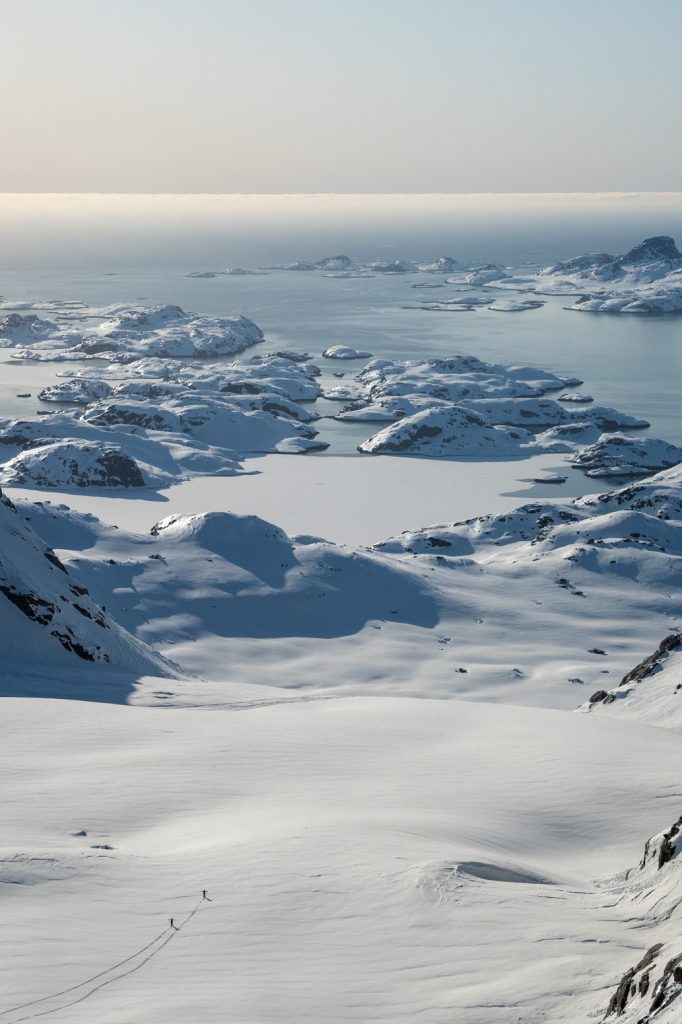
“Jess and Rachael cruise down the glacier toward Arctic waters at the end of our first day of stretching the legs in May 2022.” Photo: Sophie Danison
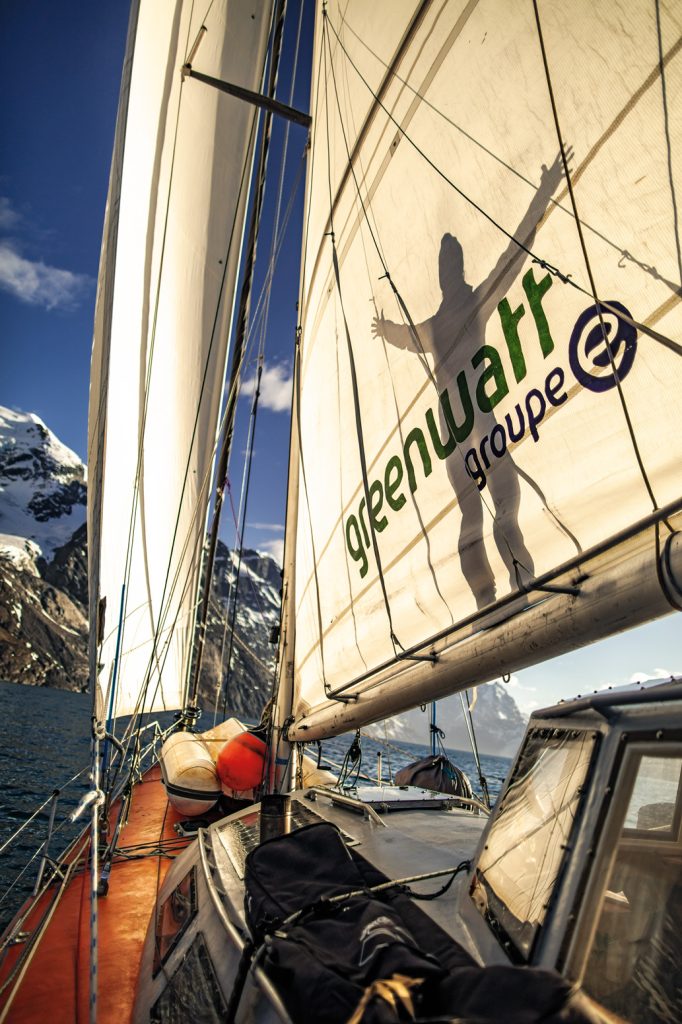
“After days of being in the clouds during our 2019 mission, a sunny evening of sailing was quite enjoyable. While we weren’t able to always sail, the wind picked up enough on this particular evening and we cruised out of the fjord under wind power before heading to our next cove.” Photo: Joey Schusler
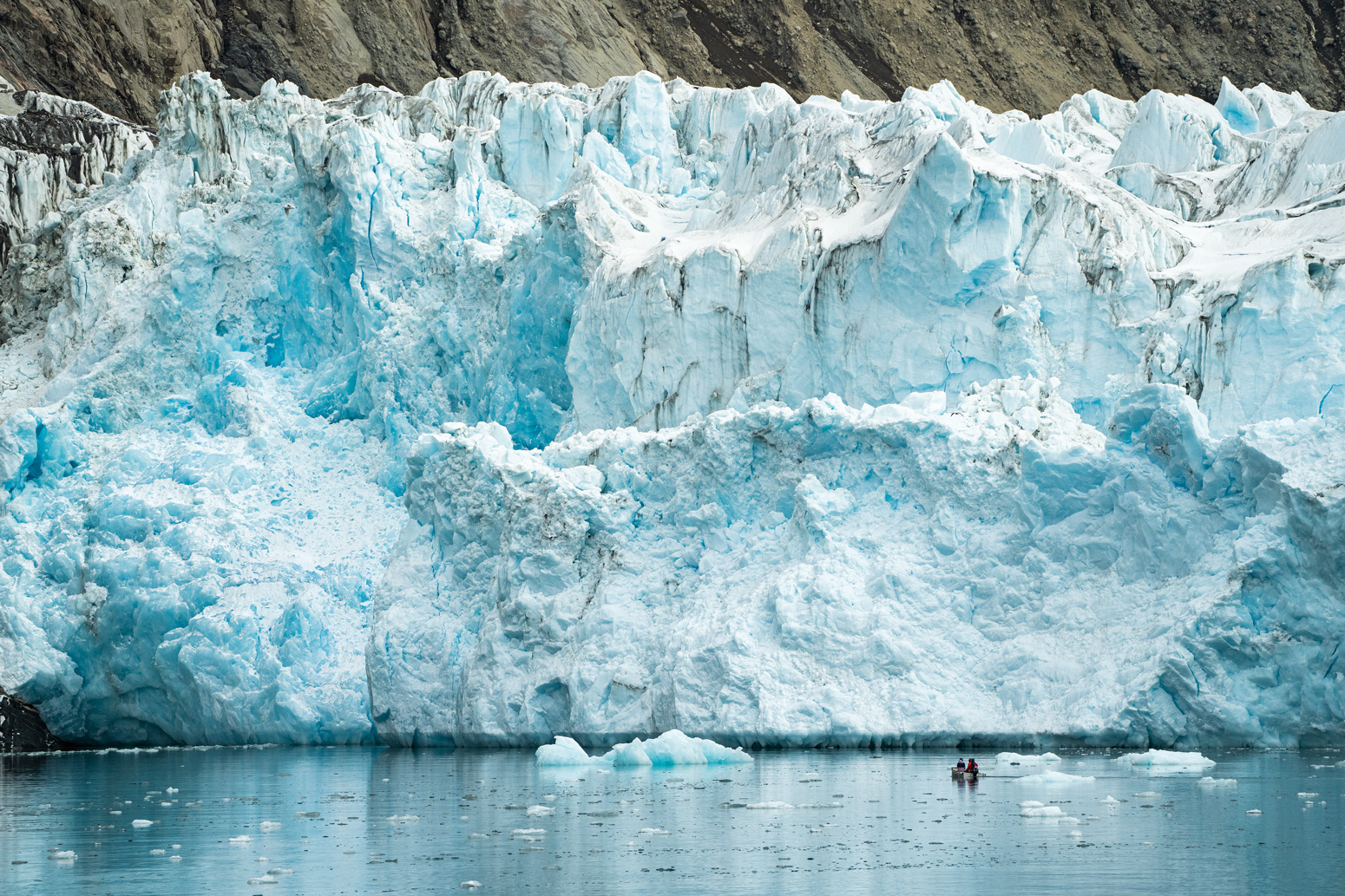
“The dinghy is dwarfed by the Taateraat Sermiat glacier, an outflow from the Greenland ice sheet. After checking out photo comparisons, the glacier has clearly receded since Jess and Rachael’s last visit in 2019.” Photo: Sophie Danison
That, as the story goes, is where I came in. Jess and I had been on several ski trips together and she had told me about skiing in Svalbard among icebergs, polar bears and reindeer. I’d always wanted to ski a line straight down to the sea. So in 2018 I jumped aboard the Knut having never sailed a day in my life and signed on to cross the Barents Sea—500 nautical miles of unforgiving Arctic Ocean. I had never felt the force of wind on a sail.
A sailboat’s happy place is ripping through water in balance between sail and keel. This means the sailboat is almost always tipping while ocean pours over one side of the railing. Wind also creates waves—which is a “duh” of sorts—but one I was not prepared for during the crossing. Along with sailing shock, once we reached the icy archipelago we had to navigate skiing through the hightest concentration of polar bears on the planet. In 2018, I got off the Knut and vowed never to sail or ski in the Arctic again.
I clearly have a short-term memory. A mere five months later, Jess pitched Greenland, and I agreed immediately. The Arctic haunts you with its vast beauty. That 2019 expedition was an overwhelming success. Still reliant on a diesel engine, we were able to motor confidently through uncharted water. When I signed up for a further investigation of Greenland in 2022, I did not understand the full implication of what it meant to “go green” in a world encased in ice.
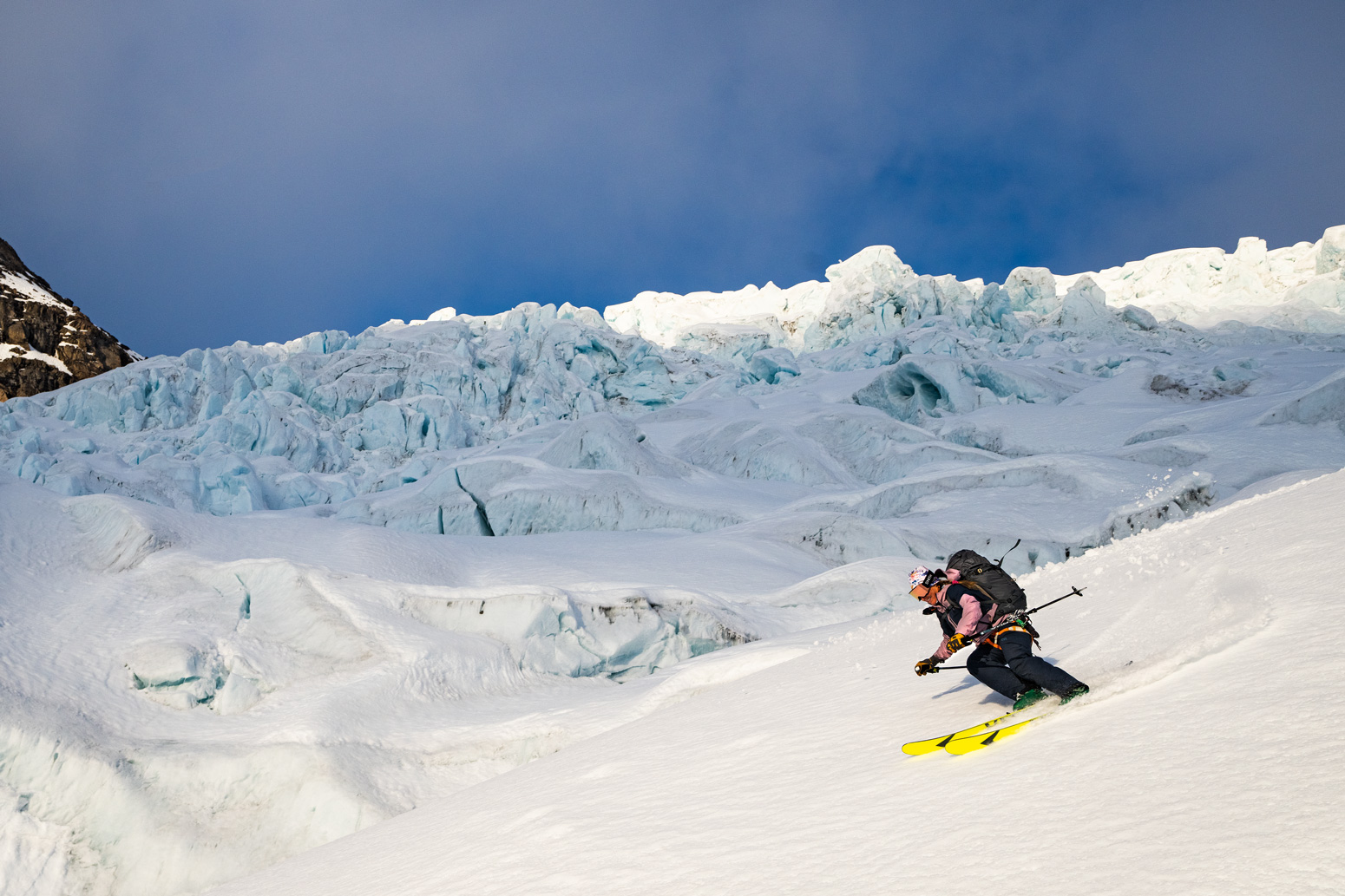
clockwise from top left (click to expand)
“Maniitsoq, a small village in western Greenland, is the launch point for many boat-powered ski trips. The town is only accessible by boat and plane, the longest road extends a total of about two miles from the airport to the other side of town. Multicolored buildings dot the village, historically each color represented the function of each particular building—a white hospital, for example. Over time many colors have lost their significance, but the buildings still hold onto their brilliance.” Photo: Sophie Danison
“A friendly Arctic fox pays us a visit on its way to the shore for an icy water break.” Photo: Sophie Danison
“Traveling in uncharted waters can be a bit challenging in a small sailboat, especially when it comes to looking for a place to anchor in the deep fjords of western Greenland. Rachael looks toward the horizon as Captain Ben tries to anchor. This was a daily battle and required the utmost diligence from our unflappable captain.” Photo: Joey Schusler
Jess arcs a turn in front of a striking glacial arm connected to the Greenland ice sheet. Photo: Sophie Danison
Shit had gotten very real. Not only did we have glaciated terrain to navigate and ski, but we now also had to rely on the power of the sun and wind. We had multiple ski zones in mind that were—this year—unreachable without a diesel engine. Surrendering to weather is how Ben believes one needs to experience sailing—seeing these stunning icy realms without diesel power. It forced us to problem solve and communicate about limitations—and on this trip they were plentiful.
You know how some call a spare tire a doughnut? A tiny, pathetic excuse for a tire meant merely to limp you to safety? Well, our backup anchor was nothing short of a doughnut. I could lift the thing with one hand and it was now the only tether keeping us from potentially floating into a massive Arctic storm. Luck was now an uncomfortably crucial element in the success of our expedition.
After hooking the spare anchor to the chain, we quickly realized the force of the storm was too great for us to stay put. I suited up in my Gore-Tex, made Ben and myself strong cups of coffee, and prepared for an all-night push in the rain to hopefully find safer anchorage. We had exacerbated our already-dwindling power supply with the solar panels not charging sufficiently due to the storm (there was no backup generator), so there could be no more failed anchorage attempts. This was our last shot before we were forced into open ocean and an intensifying 40-knot barrage.
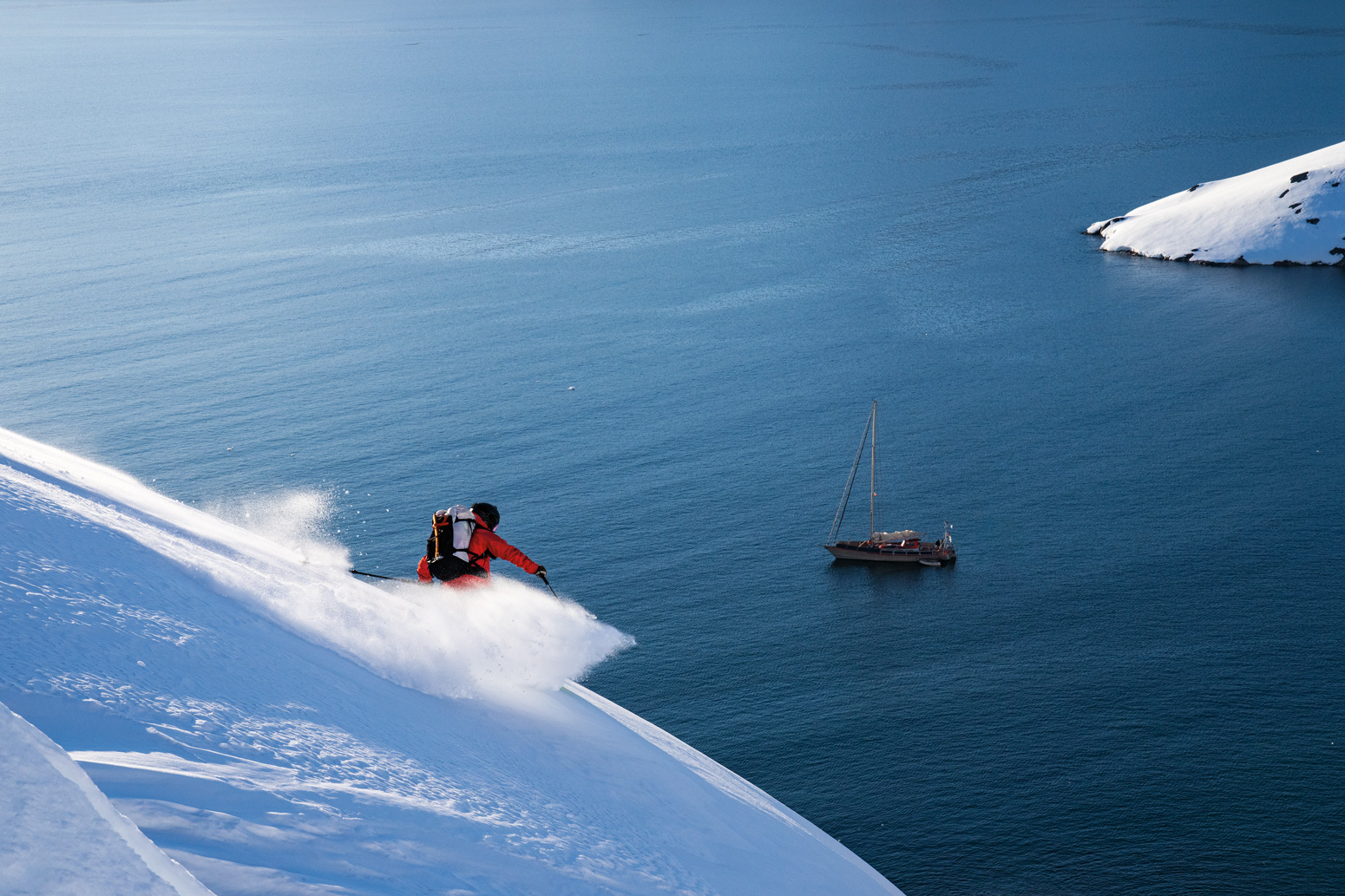
Rachael slashes a few final turns on her way back to the Knut on the last ski day of her 2022 expedition. Photo: Sophie Danison
While tacking back up the fjord, a gale-force microburst took our sail toward the water and half of the boat down with it. At the speed we were moving, a fall overboard would leave a person a quarter mile from the craft in rough seas and next-to-freezing water temps. I wasn’t tethered in—the only thing holding me onboard was my elbow hooked around the galley entrance. I screamed for Ben and saw him standing with his back against the above-water side of the deck holding onto a sheet and the helm. Moments later, after releasing tension in the sail, the keel swung us back upright. I shook, exhausted and scared, a slow rattle cranking in my ribcage.
When we finally arrived at our last safe inlet, we were crushed to see it was still 80 percent covered in ice. Without another option, we nestled up as close to the frozen bay as possible, releasing our little doughnut anchor and hoping it would hold. I took the first ice watch on what would be a long, restless night. Huge chunks of frozen sea dragged up against the aluminum siding of the boat and banged into the dinghy. When the wind shifted, our whole existence turned with it. Listening to our 65 meters of chain unwind below us, I prayed the doughnut would hang on for another anxious shift.
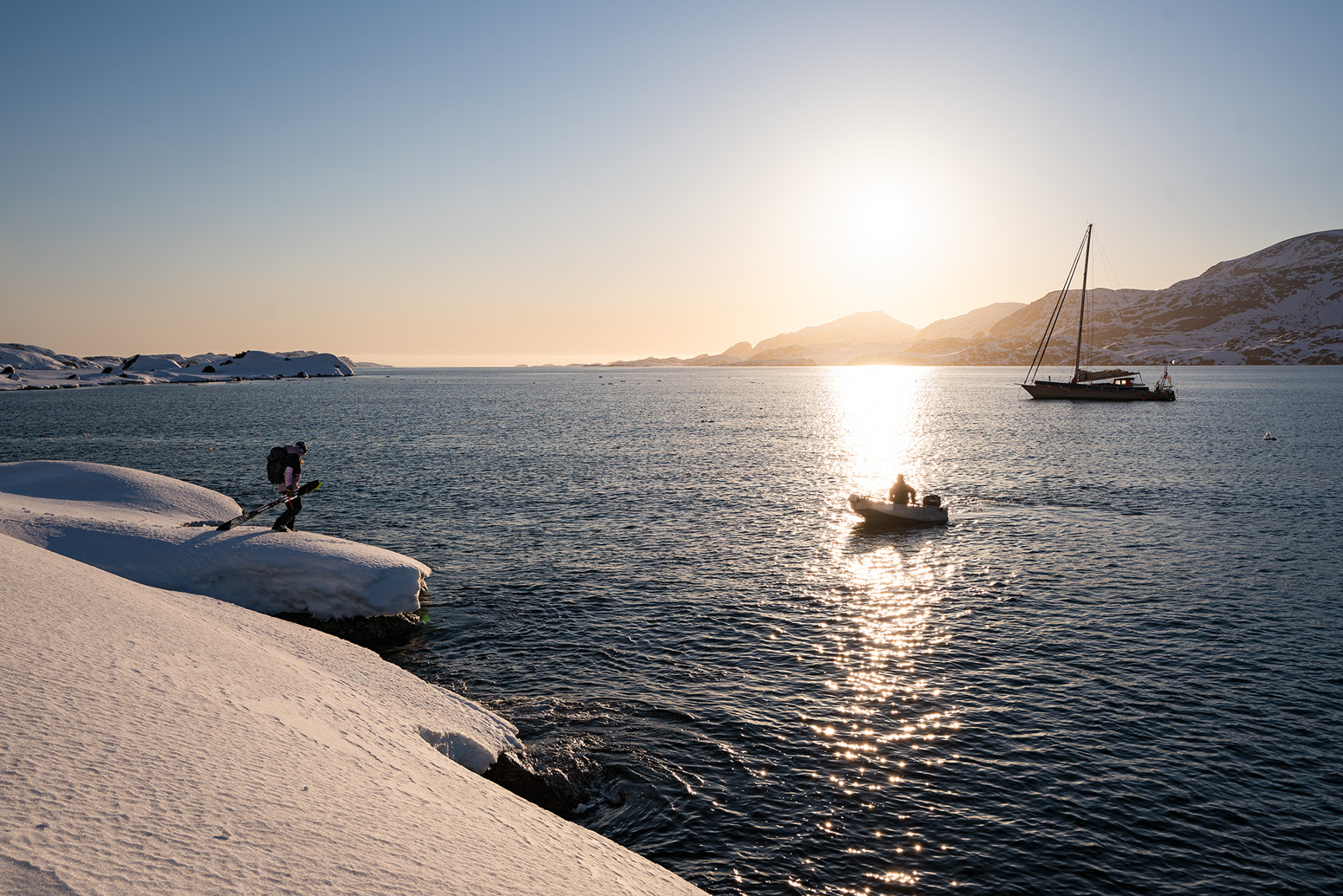
All aboard. Jess waits for Ben to pick her up in the dinghy after evening turns in Greenland’s eerie waning light. Photo: Sophie Danison
Morning finally came, and with it another ski day. Our anchor had held and water conditions had improved, but the snow was another story entirely. Conditions in Greenland are variable—every day and every zone another adventure. It wasn’t all powder—in fact most of it wasn’t. We had put all of our snow skills to the test on white ice, breakable crust and deep isothermal snowpack to enjoy a few buttery soft turns. Still, sometimes that reward was worth it, for instance our first descent of the Narcolarctic Couloir. Named after our zero-sleep sail (and the vomit-splashed decks that stained our collective memory), the 4,000-foot shot skied right to the ocean. After failing to climb it on our first attempt, our second-day success was that much sweeter. Atop the line, taking in the mile-wide river of ice pouring from the ice sheet, tears flowed freely from my eyes before freezing to my cheeks. Spanning over 660,000 square miles and reaching depths of almost 10,000 feet, it was part of an ice-sheet system between Greenland and Antarctica accounting for nearly 99 percent of the world’s freshwater. Now we were here among it, sliding across the ice to reach one of the best runs of our trip.
Flirting with the Arctic Circle, we initiated turns in sunset light, each arc appearing to be the last before darkness came. But that close to the North Pole the sun waltzed along a mountainous horizon line, pulsing between peaks as the symphony of colors lasted for hours on end. And so we skied breathless, basking in pink and yellow light—thousands of feet down to a sailboat anchored next to a glacier wall, visions of stormy seas temporarily obscured by mind-blowing lines.
Those good memories were often the I fuel needed to keep going. In many ways, this expedition pushed me to my maximum. One day I caught myself scribbling, “I’m sick of being scared,” into my onboard journal. I wasn’t craving that sort of fear-saturated adventure, but there I was, without an anchor, without power, heading toward a 40-knot Arctic storm. There’s nothing easy about sailing at the 65th parallel, and that difficulty is multiplied aboard a sustainable vessel like the Eco-Knut. But, truly reliant upon Mother Nature and no longer able to continue forward burning fossil fuels, we embraced the struggle as a necessary one—one to protect this place that had been seared into our collective brains forever. Ben saw it, and we willingly went along for the ride, sometimes charting beautiful unskied lines, but more often than not holding onto whatever piece of ship we could grab to avoid being flung into the icy ocean. In the end, it was his vision, the pursuit of Greenland’s power at its most honest, that became our true adventure.
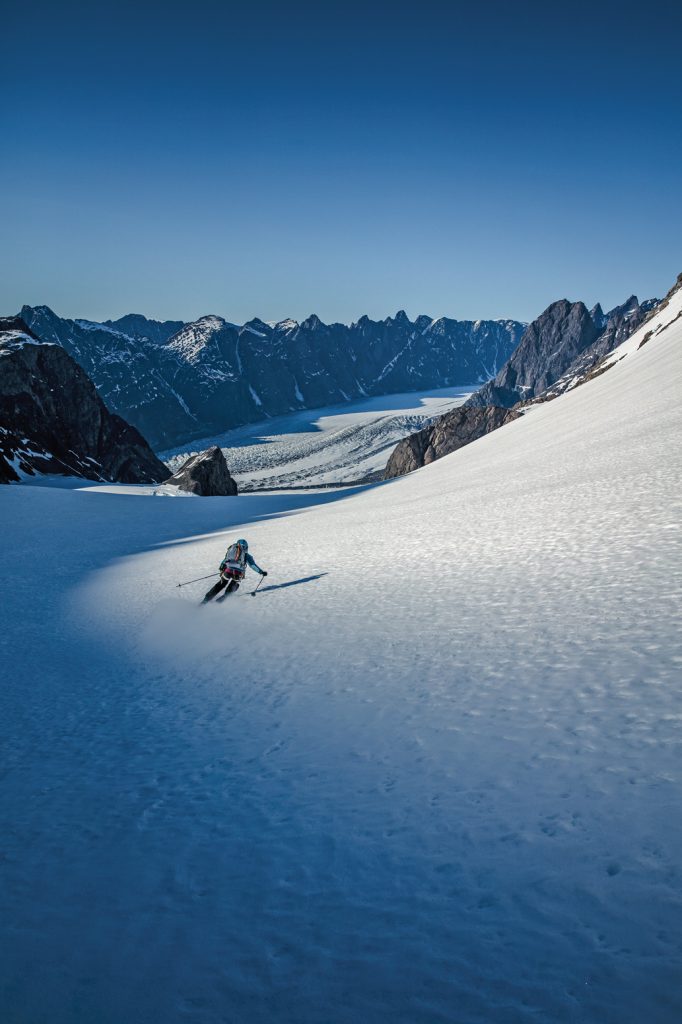
“Jess makes her way down from our fist Greenlandic summit of the 2019 trip, a several-thousand-foot run on perfect corn in the receding daylight. We would often find ourselves skiing late into the evening with the long days of spring in effect at that high latitude.” Photo: Joey Schusler
